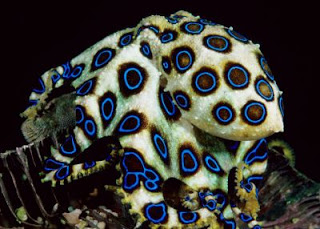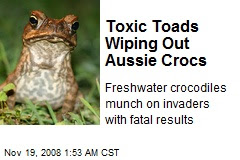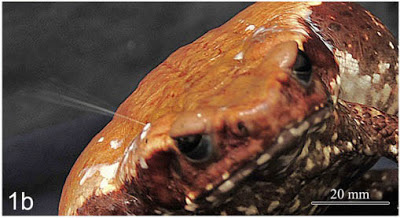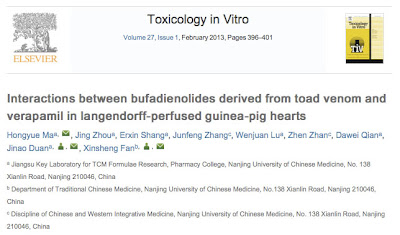Biology
Wolverine from the X-Men is a mammal, but let?s use him as a model for a couple of particular amphibians. Amphibians have developed many different kinds of defenses against predation, but perhaps the most exceptional are found in a certain salamander.
The ribs have joints where they meet the spine, and the muscles attached to them pull them forward. The hunching then pulls the skin taut - and here come the sharp points, just like Wolverine.
There is a possibility that P. waltl still sequesters toxin despite his non-toxic environment. Many animals, like the blue-ringed octopus, use toxins that are produced by microbes on, in, or around their bodies. Even if fed a non-toxic diet, if P. waltl harbors a bacterium that makes toxin and P. waltl passes that bacterium vertically to its offspring, it could be a source of newt toxin even in the laboratory environment.
Cane toads introduced into Australia are a classic example of bufotoxins at work. The toads have killed thousands of native animals that have eaten them, so scientists are putting out sausages made with a little bit of cane toad poison, in an effort to teach native animals not to eat the toads.
Primary and secondary poisons secreted on the skin are usually considered passive defenses. They only go into action when the animal is bitten. Predators usually learn quickly to avoid that kind of animal ? if they aren?t already dead. This is why poisonous frogs are often colorful, it helps the predators recognize them as something bad to eat. This kind of defense is the opposite of camouflage, and is called aposematism.
Finally, Dr. Carlos Jared pointed out that in the latin-based languages of Portuguese and Spanish, the words venom and toxin mean exactly the opposite of what they mean in English. It is easy to see then how a term like ?toad venom? could become ingrained even in the scientific literature. Warning ? be precise in your language, or you could be the source of an unfortunate mess.
Savitzky, A., Mori, A., Hutchinson, D., Saporito, R., Burghardt, G., Lillywhite, H., & Meinwald, J. (2012). Sequestered defensive toxins in tetrapod vertebrates: principles, patterns, and prospects for future studies Chemoecology, 22 (3), 141-158 DOI: 10.1007/s00049-012-0112-z
Heiss, E., Natchev, N., Salaberger, D., Gumpenberger, M., Rabanser, A., & Weisgram, J. (2010). Hurt yourself to hurt your enemy: new insights on the function of the bizarre antipredator mechanism in the salamandrid Journal of Zoology, 280 (2), 156-162 DOI: 10.1111/j.1469-7998.2009.00631.x
Trefaut Rodrigues, M., Felipe Toledo, L., Kruth Verdade, V., Maria Antoniazzi, M., & Jared, C. (2011). The Amazonian toad Rhaebo guttatus is able to voluntarily squirt poison from the paratoid macroglands Amphibia-Reptilia, 32 (4), 546-549 DOI: 10.1163/156853811X603724
For more information, see:
- Amazing Facts About Amphibians
Some frogs can be frozen solid, then thawed, and continue living.Some frogs can pull their eyes into their throat and help push food down!Frogs live on all continents except Antarctica.Wood frogs can be frozen solid and then thawed, and continue living....
- It?s An All Or None Proposition
Biology concepts ? toxin, venom, cnidarians, kleptocnidae In our discussions of venoms and toxins we have looked at many groups (phylums) of animals. In each phylum we have identified at least one venomous animal. We have talked venomous amphibians (frogs,...
- Sneaky Snakes: Biters, Boobytraps, And Spit
Biology concepts ? venom, toxin, poison, fangs, evolution, toxicofera hypothesis The California Red Sided Garter Snake is one beautiful reptile. It has round pupils, so it might be non-venomous, but it has a highly patterned and bright colored body,...
- The Best Offense Is A Good Defense
Biology concepts ? venom, mammalian defenses, poison, toxin, sequester, honest signals Humans are much of a match for most large predators, we have to rely on our wits to get us out of dangerous situations. Or better yet, KEEP us out of dangerous situations....
- One Man?s Poison Is Another Man?s Cure
Biology concepts ? toxin, poison, venom, LD50, ED50, therapeutic index The skull and crossbones is the most recognized symbol for poison. It originated at the entrances of Spanish cemeteries, so it has always been associated with death. With advent of...
Biology
A Salamander Superhero?
Biology Concepts ? primary and secondary toxin, passive and active defense, venom, poison, toxin salamander, newt
 |
Wolverine is a comic book character, as well as a recurring movie character played by Hugh Jackman. It?s hard to believe that this is the same man who played John Valjean in 2012?s Les Miserables. Convict 24601?s tribulations would have been easier if he had had those claws! |
Wolverine had a skeleton that was reinforced with an indestructible metal, could protrude some nasty claws or spines from his hands, and could heal his wounds very quickly. Well, so can Pleurodeles waltl, the Spanish ribbed newt. What is more, our newt friend can go Wolverine one better; P. waltl also produces a toxin and secretes it through its skin!
For clarity sake, P. waltl is actually both a salamander and a newt. All newts are salamanders, but not all salamanders are newts. Salamanders are newts if they fall into one of five genera. In general, newts spend a little more of their lives in or near water, and it is easier to tell male and female newts apart ? but there are exceptions in each of these categories.
Egon Heiss at the University of Vienna published a study in 2009 that looked at the unique defense mechanism of P. waltl. It is definitely a poisonous amphibian, secreting a harmful substance primarily from glands at the base of its neck, but from other points along its skin as well. This toxin is noxious and irritating when absorbed through human membranes, but is lethal when injected into mice. And a method of injection is just what P. waltl has evolved.
The ribs of this (and the crocodile newt) amphibian are specially designed and aligned so they can be used as weapons. The ribs themselves are very thick at the proximal end (the end where they attach to the spine), but they taper to points at the distal end. They also have gentle curves downward in the first half, but back up again in the distal half. Each rib is also curved slightly forward.
On X-ray, these look impressive, but they are inside the salamander?s body so they still pose no danger. Beware the secret weapon! When P. waltl is threatened, they go to work. First, the salamander will start to secrete its toxin onto its skin. Then it will assume a hunched posture. By arching its back and holding that position, its rib points actually pierce its own skin and stick out like spines!
 |
Here are pictures from Dr. Heiss? paper. On the left you can see the hinge?s on P. waltl?s ribs that allow them to move to become weapons. You can also see the points on the ends versus the strong bases to keep them from breaking. On the right is the posture that P. waltlassumes to force the rib tips through its skin. The picture only shows a moderate attempt. They can stick them out much farther if needed. |
There are orange spots along the sides of P. waltl that correspond to the points where the ribs protrude, and these themselves are interesting. For some reason, the way the ribs are covered with a connective tissue sheath, and something about the orange spotted skin makes it so the salamander can very quickly heal his self-inflicted wounds - just like Wolverine!
The poison on the skin can be transferred to the wounds created on the would-be predator by the sharp rib points (whether on the skin or in the mouth) allowing the poison to enter the tissues, and making it much more toxic. Does this make P. waltlvenomous as well as poisonous? You could argue that point. A venom usually isn?t absorbed through the skin or mucous membranes, but this salamander?s poison is absorbed, so maybe it isn?t a classic venom. But it is a toxin that uses a natural delivery system to enter the tissues of the victim like a venom, so the argument is on.
We can use P. waltlto discuss a larger issue in poisonous amphibians. As a salamander, not much is known about where its poison comes from. He may take the poison from the food he eats, whether it be plant or insect, or he might produce the toxins through his own biochemistry.
I talked to Dr. Heiss about this issue in P. waltl. He said that he has raised eight generations of the spine ribbed salamanders in the lab, feeding them very non-toxic diets. Yet, he has been stuck in the finger by a rib and this finger swelled and stung much like a bee sting. He takes this as anecdotal evidence that P. waltl makes its own toxin.
 |
The blue-ringed octopus is one of the most deadly animals in the seas. It lives in the shallow coastal waters off Australia and Indonesia. Its venom is a secondary toxin. In 1989 it was suggested that several bacteria might be producing the toxin in the octopus' salivary glands. This same toxin is taken up by many very different animals, like octopuses, pufferfish, newts, and snails, so the idea that is produced by something else is logical. |
Much more is known about poisonous frogs. Poison dart and other poisonous frogs gather their toxins from the food they eat, mostly poisonous beetles, ants, and especially poisonous orbatid mites. They then sequester the toxins in glands on their backs or elsewhere on their skin. As these frogs don't make their own poisons, the toxins are called secondary toxins.
Most poisonous frogs sequester toxins from their prey, but not all. Frogs of the genus Pseudophryne(like the Corroboree Frog of Australia) make their own toxin in addition to sequestering toxins from their diet. Dr. Alan Savitzky at Utah State University told me that diet does play a role, as the pseudophryne frogs make toxin themselves only when their toxin-producing prey is not available. This saves ATP; making toxin is a waste of energy when it is readily available from the environment.
Other amphibians, like most poisonous toads, use primary toxins, meaning that they produce them by their own physiology. True toads (family Bufonidae) commonly make a toxin called bufadienolide inside skin glands; the starting molecule they use is cholesterol. Too much cholesterol can kill you in several ways!
 |
Cane toads are not native to Australia in 1935 from Hawaii to try and control the sugar cane beetle. That?s weird, most times, it is things introduced TO Hawaii that cause problems, not FROM Hawaii. It isn?t too strange to think a cane toad cold kill a crocodile when you realize that an adult cane toad can weigh 2kg (4.5 lb)! |
However, the exception to primary toxins in toads is in the genus Mealnophrynicus. These toads make toxin, but they also sequester toxin, much like the pseudophryne frogs. These sequestering and toxin producing exceptions are discussed in the wider context of sequestered toxins in Dr. Savitzky's great 2012 review paper in Chemoecology.
Some animals are smart to use the toxins of their prey - some poisonous frogs are even smarter; they add their own biochemistry to the toxins they steal. Take some dendrobatid frogs for example. They aren't satisfied with merely using the toxin they sequester, they make it more potent by changing it's chemistry. They can hydroxylate a dietary toxin called pumiliotoxin to become allopumiliotoxin. The allo-version is about 5x more toxic than the version they eat!
So, is this modified toxin a secondary toxin, or has it crossed over into being a primary toxin? So much is grey area. Let?s pile on another exception. In some cases, toxins that an animal eats are spread throughout is body, either in a biologic effort to make its tissues toxic, or just because they have not been broken down by the body yet. This is called toxin retention, and is a separate mechanism from toxin sequestration in glands specifically designed to concentrate the consumed toxins.
 |
Here you can see the toxin from R. guttatusbeing squirted out of a gland on its back. This is a unique activity for toads (as far as we know), but there is a salamander that can do it too. I guess nothing in biology is 100% true, and nothing is unique to a single organism. The picture is from Dr. Carlos Jared?s 2011 paper. |
Poisonous toads usually have a passive defense, even if some of their toxins are lethal, but there is an exception - wouldn't you know it. The Amazonian toad Rhaebo guttatus can become more active in use of its primary toxin. R. guttatuscan voluntarily squirt its toxin from the glands on its back, and can aim it at a predator! This defense was described in 2011 by Carlos Jared and his team in Brazil, even though the toad was first discovered over 200 years ago! The toad inflates its lungs, creating pressure in the skin on its back, and expelling the toxin. The direction is based on subtle movements of the toad's skeleton and musculature.
This leads to a final point that reminds us how much communication plays a role in science, and how it is a group activity. When looking for exceptions in amphibian toxins, I kept coming across papers about ?toad venom,? but when I read the papers, they were really talking about toad toxin; they were never delivered below the skin.
I starting asking scientists why this might be, and I got several answers. Some tried to make an argument that venom just means that it is sequestered in glands ? I reject this argument. Dr. Savitzky said that many scientists are guilty of using the term incorrectly, but it persists because of ?cultural inertia.? I buy this explanation ? I think it explains other weird occurrences, like Justin Bieber?s popularity.
 |
| Here is a recent scientific paper that uses the phrase ?toad venom.? I did a computer search in the best medical research database there is, and ?toad venom was used 88 times, while ?toad toxin? was used only seven. Even more illustrative, a search for both words toads + venom showed 4500 papers, but toad + toxin, only 350. Misuse of the of the phrase is rampant, even in the people who study them! |
Next week, talk about some weird examples of venom in snakes; or are they poisons - if you spit it, is it still a venom?
For more information, see:
Spiny-ribbed salamanders ?
http://www.arkive.org/sharp-ribbed-salamander/pleurodeles-waltl/image-G62801.html
http://news.nationalgeographic.com/news/2009/08/090828-spanish-newt-ribs-spines-wolverine.html
http://en.wikipedia.org/wiki/Iberian_ribbed_newt
http://www.amphibiaweb.org/cgi/amphib_query?where-genus=Pleurodeles&where-species=waltl
http://www.wildlifeextra.com/go/news/spanish-newt.html#
http://www.ribbednewts.com/
http://www.caudata.org/cc/articles/Pleurodeles_defense.shtml
Cane toads ?
http://www.pestales.org.au/lessonplans/toadtrap.htm
http://whyfiles.org/2010/tracking-traveling-toads/
http://education.brgcma.com/index.php?page=biodiversity
http://www.documbase.com/Story-of-Cane-and-Able.pdf
http://www.doc-txt.com/cane-toad-lesson-plan.doc
www.uwsp.edu/cnr-ap/wcee/library/Documents/InvasiveSpecies.pdf
www.imdb.com/title/tt0130529/
http://animals.nationalgeographic.com/animals/amphibians/cane-toad/
http://australianmuseum.net.au/Cane-Toad
http://www.canetoadstheconquest.com/
http://www.canetoads.com.au/
http://www.invasivespeciesinfo.gov/animals/canetoad.shtml#.UTJDW4Vf13I
Aposematism ?
http://www.google.com/url?sa=t&rct=j&q=&esrc=s&source=web&cd=1&ved=0CDAQFjAA&url=http%3A%2F%2Fweb.ics.purdue.edu%2F~rodw%2FFNR-470-W%2520Coloration%2520Exploration%252012.pdf&ei=s0UyUfqkNaaZ0QG57oGIAQ&usg=AFQjCNEQv3kbgL_DKGU9j5-wCb-JJlLVrw&bvm=bv.43148975,d.dmg
http://www.tes.co.uk/teaching-resource/Aposematic-Coloration-6260829/
www.suu.edu/pva/artgallery/lessonplans09/pdf/InsectCamo.pdf
http://www.google.com/url?sa=t&rct=j&q=&esrc=s&source=web&cd=7&ved=0CFIQFjAG&url=http%3A%2F%2Fkingfish.coastal.edu%2FGK-12%2F_media%2F08%2Fplans%2Fmiddle_school%2Famphibian-lesson-plan.doc&ei=s0UyUfqkNaaZ0QG57oGIAQ&usg=AFQjCNFoV-dyUUGJSz9GE6OrvXzilmV-ZQ&bvm=bv.43148975,d.dmg
www.monarchlab.org/mitc/newsletters/mitc_newsletter_2004.pdf
http://www.apheloria.org/Paul_Marek/Aposematism.html
http://www.amentsoc.org/insects/glossary/terms/aposematism
http://www.eoearth.org/article/Aposematism
http://www.seaslugforum.net/find/926
http://en.wikipedia.org/wiki/Batesian_mimicry
- Amazing Facts About Amphibians
Some frogs can be frozen solid, then thawed, and continue living.Some frogs can pull their eyes into their throat and help push food down!Frogs live on all continents except Antarctica.Wood frogs can be frozen solid and then thawed, and continue living....
- It?s An All Or None Proposition
Biology concepts ? toxin, venom, cnidarians, kleptocnidae In our discussions of venoms and toxins we have looked at many groups (phylums) of animals. In each phylum we have identified at least one venomous animal. We have talked venomous amphibians (frogs,...
- Sneaky Snakes: Biters, Boobytraps, And Spit
Biology concepts ? venom, toxin, poison, fangs, evolution, toxicofera hypothesis The California Red Sided Garter Snake is one beautiful reptile. It has round pupils, so it might be non-venomous, but it has a highly patterned and bright colored body,...
- The Best Offense Is A Good Defense
Biology concepts ? venom, mammalian defenses, poison, toxin, sequester, honest signals Humans are much of a match for most large predators, we have to rely on our wits to get us out of dangerous situations. Or better yet, KEEP us out of dangerous situations....
- One Man?s Poison Is Another Man?s Cure
Biology concepts ? toxin, poison, venom, LD50, ED50, therapeutic index The skull and crossbones is the most recognized symbol for poison. It originated at the entrances of Spanish cemeteries, so it has always been associated with death. With advent of...
